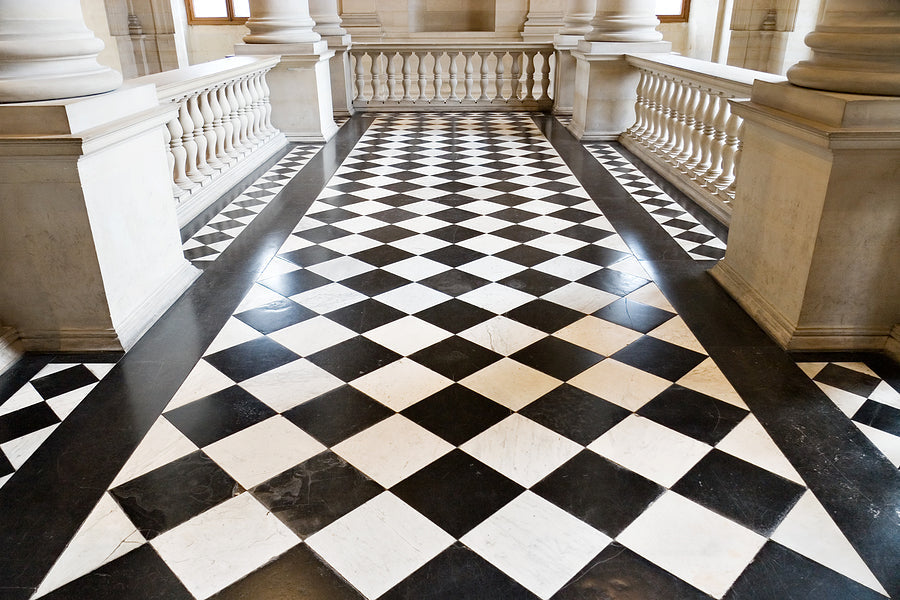
Why Have Chequerboard Tile Patterns Always Been Popular?
Share
One remarkable aspect of our range of luxury vinyl tiles is that many of the most popular choices for residential, retail and industrial uses are in some ways inspired by nature, even if that connection is not always entirely obvious.
The most clear examples of this are stone and wood-effect vinyl, which has been the case even since the days of Linoleum, but some patterns that we do not necessarily associate with natural origins also find inspiration in nature.
This includes perhaps the single most popular pattern in human history: the chequerboard. The characteristic pattern of dark and light squares is one of the most perfect aesthetic approaches when using tiles and is remarkably versatile as a design, whether it is used for luxurious homes, utilitarian kitchens or striking retail spaces.
However, what is more of a mystery is why chequerboard designs seem to have been around forever, and whilst archaeology is still looking for a complete answer, there are some places in which we can find clues.
Where Does The Name Come From?
The word chequer, as used to describe a particular pattern, dates back to at least the late 12th century, as the pattern was traditionally used by the Exchequer to tally and audit the accounts of barons and sheriffs, many of whom could not read, write or calculate arithmetic using numbers.
The Exchequer would use the different squares to tabulate pounds, shillings and pence and make it easier to count. Eventually, it became recognised as a pattern in its own right that was frequently used in heraldry and textiles.
However, whilst this is the origin of the British political role of the Chancellor of the Exchequer (literally the secretary of the chequerboard), or the person in charge of financial policy, the term itself dates back further than this and does relate to the familiar game board that uses the same pattern.
The Pattern Of The Game Of Kings
The word chequer comes from the Old French word eschequier, which not only describes a chess board, but also the game, its pieces and the act of checkmate itself.
Chess is one of the world’s oldest games, and eschequier originated from the Latin word scaccarium, which itself originated as a variation of the word shatranj, which was the Sassanid Persian Empire (now modern-day Iran) version of the Indian game known in Sanskrit as chaturanga.
Chaturanga is believed to be the earliest form of chess ever invented, but it did not actually use a chequerboard; this was an innovation that was developed through shatranj, spreading to Europe in the 10th century.
However, it is possible that the checkerboard pattern predates its use in chess, as shatranj adopting what would become known as the chessboard appeared to be the result of European players adapting the rules to existing gameboards rather than the other way around.
Droughts is one of the oldest games in existence, with the British Museum having boards that date back over 3000 years. Whilst there are significant variations in board designs and rules, it is very possible that some of the earliest uses of the chequerboard pattern originated through its use in games.
Whilst there is an irony that a pattern beloved by businesses has its origins in games, it is possible that the chequerboard pattern has no origin at all, and has existed in nature since time immemorial.
Order By Nature
The earliest known example of someone wearing a form of chequerboard pattern (albeit closer to a prototype tartan) is the Cherchen Man, with examples also seen in Ancient Rome and in the Bronze Age, but it is possible that the chequerboard design has neither a creator nor a true human origin.
The chequered beetle, known as the Cleridae, is a relatively large family of insects worldwide with recognisable patterns, some of which are remarkably close to the ordered chequerboard regularly used today.
Similarly, the chequered skipper (carterocephalus palaemon) has an even more distinctive pattern of orange and brown spots.
However, the chequered garter snake (Thamnophis marcianus) has a particularly clear set of dark and light patterned squares on its skin, making it the closest analogue to the chequerboard pattern we recognise today, even if the fact that it is native to North and Central America means that it may not necessarily be the direct inspiration.
Weaving patterns inherently lead to chequerboard patterns by the nature of how most simple patterns are created, meaning that the origin of the chequerboard pattern in humans can be as old as 12,000 years ago.
